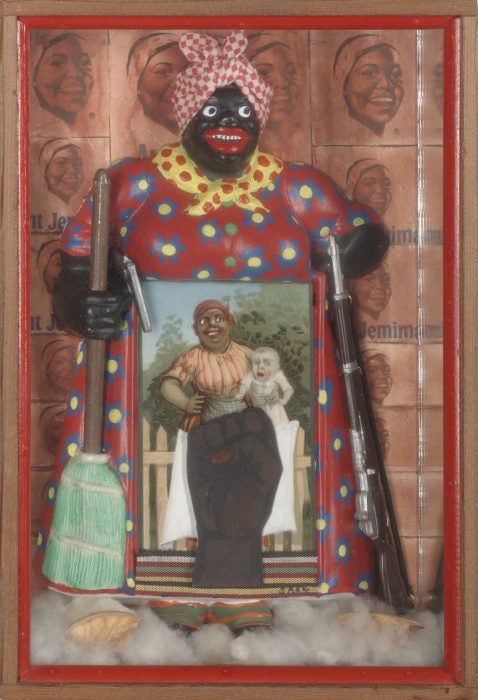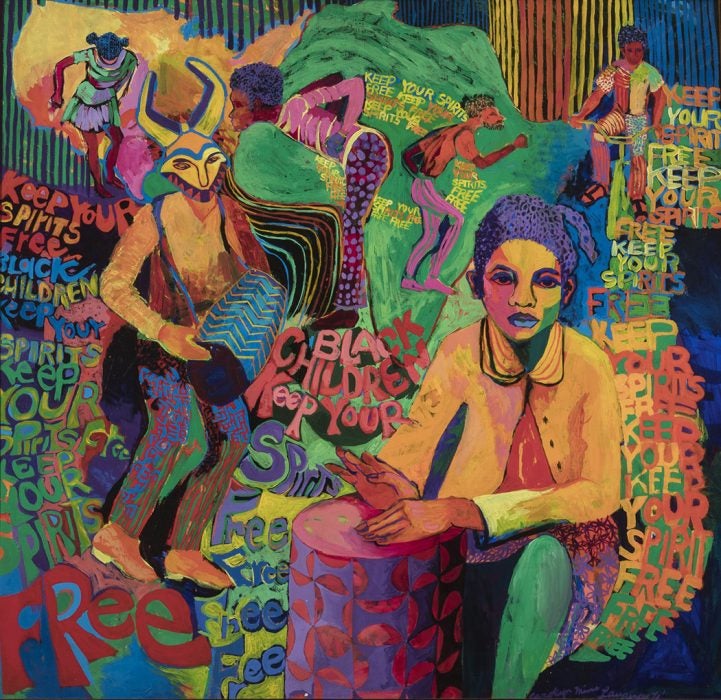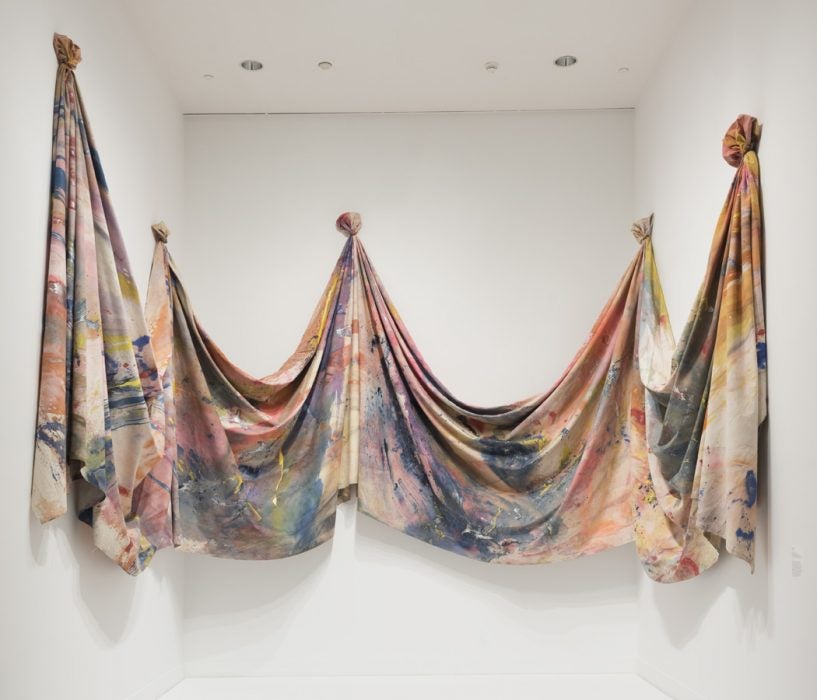There is music playing in the entryway of the gallery housing the Brooklyn Museum’s new exhibit, “Soul of a Nation: Art in the Age of Black Power.” James Brown played on my visit, a reminder of the many ways art played a role in bringing stories of Black life into the everyday. The works on display all demonstrate that art is a marker of what matters, what hurts, and what heals, and that art serves as a powerful way to write yourself into a history that often threatens your erasure.
The exhibit, on display from September 14, 2018, to February 3, 2019, shines a light on Black artistic practices, explained museum director Anne Pasternak during a preview of the exhibit. It asks if there should be, could be, or even is a Black aesthetic. Black artists, like many others, grappled with the idea of what, and who, their art was for. These works ask whether Black art could or should stand in opposition to dominant artistic practices. Should it instead be its own valuable entity, unrelated to European art traditions?
Get Our Newsletter
“The show brings together artists who questioned the Black aesthetic and those who had an answer. It can only offer a glimpse into a longer practice,” the show’s curator Ashley James tells me. “The show answers the question of Black aesthetic by surveying and charting the landscape.”
As the art historian Julie L. McGee writes in Callaloo: “Black artists’ historical omission, invisibility, and derisory representation in art discourses are unfortunate but very real aspects of American art history.” How, then, to reclaim that space and create works that not only assert your presence, but say something about a larger experience? “Soul of a Nation” examines how artists have reckoned with that omission.
Spanning two floors, the first floor of the exhibit is arranged by region—beginning with New York—and starts with works from the Spiral group, formed in 1963 by Romare Bearden, Charles Alston, Norman Lewis, and Hale Woodruff. Painted in a soft, pale color, the gallery walls create a striking contrast to the black-and-white works on display. The Spiral group contemplated the notion of a conspicuously Black art—what it would look like, what it would mean to create it, and what role, if any, the artist had to play in the struggle for civil rights.
There is the abstract expressionist depiction of a Klan rally in Norman Lewis’ America the Beautiful (1960), its white hoods shining through a black background. Lewis asks us to look, to remember, to realize that this is American history—for both white and Black America. In this way, the question of the Black aesthetic is answered in a way that places Black artists as historians, and shows how their exclusion from all aspects of society was created and enforced.
This gallery is also home to works by New York’s Kamoinge photography collective. They reclaimed their space by showing Black life in vivid detail. They show the business of living, of being Black, of everyday-ness. It’s not political, at least not overtly, but the precision of the imagery, the care with which Black life is depicted is radical. These are “gestures rooted in blackness and Black life,” Ashley James says.
Those gestures become more pronounced in the next room. As we move into the Black Power era of the mid-1960s, the walls become a bright white, signaling the era’s “new boldness and rambunctiousness,” says James. In this era, the Black art world doesn’t diverge much from the Black political world. There was a disillusionment with non-violence, with waiting for freedom. Here the Black aesthetic asks for inclusion in America’s story, but with a keen knowledge that, with or without permission, that story was going to be told.

The work pulses with the energy of an empowered and boldly political movement, and reclamation takes a few forms. It’s not just the assertion that decidedly Black stories belong in these spaces, but a reclamation of that which has harmed you. Patriotic imagery is repurposed as a statement on Black life and belonging. In Faith Ringgold’s American People Series #18: The Flag is Bleeding (1967), an American flag drips blood, the country’s violent past and present on full display. In Betye Saar’s The Liberation of Aunt Jemima (1972), a mammy figure is given a broom, but also a gun as she stands behind a raised Black Power fist. Saar seeks to acknowledge and reclaim this history, a past that lingers because of its belief in a more powerful future. It is also in this late 60s-early 70s period that we start to see art being used more overtly as activism—not just a reflection of its time, but another powerful tool in the struggle for equality.
Political organizations like the Black Panther Party incorporated the works of graphic designer Emory Douglas into its activism. His bold graphic art, done as part of his role as Minister of Culture for the Black Panther Party, is on display in the exhibit’s Bay Area section. Douglas used his work as both a means of communication (his work often graced posters and newspapers to promote the BPP’s message) and as a straightforward response to issues of the day.

Groups like Chicago’s AfriCOBRA (African Commune of Bad Relevant Artists) were, as the art historian Kirstin L. Ellsworth writes in Civilisations, “visualizing a universal Black identity,” and within that vision was the idea that Black people had something to be proud of, something to celebrate. AfriCOBRA artists Carolyn Lawrence and Gerald Williams, for example, used their work as uplift, knowing nods to a people in struggle that this was a movement in unity. Lawrence’s Black Children Keep Your Spirits Free (1972) and Williams’ Say it Loud (1969) are both rendered in the distinct style of the collective, giving the impression that not only were the artists working for and with the people, but with each other as well. In this way, art isn’t something separate from the fight, it is the fight.
The first floor’s regional grouping builds on this idea of art as politics. As the art historian Kellie Jones writes in South of Pico, her extensive survey of Black art practices in 1960s and 70s Los Angeles, “African American migration in the nineteenth and twentieth centuries was nothing less than black people willing into existence their presence in modern American life.” There is meaning derived from place, both from an artist’s relationship to her physical location and from her place in society at large. Black artists wanted to have their position recognized, and, as Jones writes, they found recognition in the “materials of loss and of possibility, and sense of reinscription of the new in style and practice.”

This exploration of the new is felt in the second floor of the exhibit, which features work that not only touches on the political, but reimagines how the Black body and the Black aesthetic could be seen. These are works that reposition blackness on a global scale, experiment with new materials and forms, and imagine a future freedom. The abstraction in Alma Thomas’ painting Wind, Sunshine, and Flowers (1968); Tom Lloyd’s flashing, electronic sculpture Narokan (1965); and the bold, jazz influenced D9 Flat 5th (1969) by Daniel LaRue Johnson all imagine an artistic practice that both recognizes and breaks boundaries. The draped form of Sam Gilliam’s Carousel Change (1970) acts as a sort of dividing line between the exhibit floors, offering yet another answer to the question of the Black aesthetic—namely, that it can be boundless and free. The exhibit’s sole non-U.S. artist, Frank Bowling’s series of map paintings positions blackness as a global diaspora, his fading, borderless maps suggesting a non-restrictive, freeing unity.
This level of the exhibit also displays work that isn’t, at least at first glance, solely about a political moment. There are bright and bold portraits of Black life: Emma Amos’ portrait of her babysitter Eva; Alice Neel’s portrait of fellow artist Faith Ringold; and Beauford Delaney’s portrait of a smiling figure who some believe is the author James Baldwin, are all quiet moments. Perhaps the political is felt sometimes in its absence, and these moments of joy are political. These are images of Black people just being people, and that can be radical and powerful.
This second level also has its eye on the future, with artists like Fred Eversley, a former aerospace engineer, whose resin sculpture Untitled (1972) feels like it could be taken from the set of a sci-fi movie—or positioned on the stage of a Sun Ra performance. Not surprisingly, the exhibit also features work by Joe Overstreet, who did, in fact, paint backdrops for the Afrofuturistic jazz musician. These are artists imagining a future that includes Black people, a future made for and by them.
Despite featuring works from the past, it’s hard to walk through “Soul of a Nation” without thinking of the present. Although these artists were creating in their time, there is something timeless about the show and its scope. “There’s resonance because we’re seeing some of the same issues,” says James. “There’s an urgency around the artwork, a need to respond to to what’s going on right now.” The past and present are hard to untangle from one another. Black people today are asking to be seen and to be valued, an idea that isn’t so different from what the artists in this exhibit were asking.
Collectives—from Spiral to AfriCOBRA to the experimental works presented in New York’s avant-garde Just Above Midtown gallery—were formed precisely because these artists weren’t being seen by the mainstream. If their art wasn’t being seen, art that represented visions of what Black life looked like, then by extension those visions weren’t being seen, and those lives were being ignored. When we are in a moment where so many marginalized voices just want to be heard, it’s difficult not to see this show as a statement on our current political moment. And in some ways, of course it is; nothing can stand without the tint of present over it. But it also stands, quite powerfully, as its own moment of Black artists finding and asserting their place in art history.
The last section of the exhibit also has music playing, a callback to the entrance. This time, instead of the relative emptiness of the entryway, there is a recorded performance of dancer Houston Conwill’s 1983 piece Cake Walk, which debuted at Just Above Midtown. This work incorporates modern movements with those from a dance of the same name that was historically performed by enslaved people. The gallery also features photographs from Lorraine O’Grady’s 1983 performance Art is…, where everyday Black people attending the African American Day Parade in Harlem were framed by gold picture frames held by O’Grady and her dancers. This space is a reminder that life can be art, movement can be art, and that the question of the Black aesthetic may never be settled, nor should it be. It is a living act, constantly providing meaning to the world around it.







